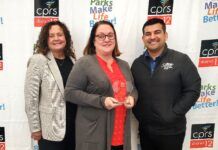
Over 130 trees were planted at El Cajon and Santee parks on March 12, part of the nearly 2,000 trees placed in 28 urban communities across California as part of the AMPlifying the Urban Forest initiative. About 150 volunteers turned up to plant 60 trees at Woodglen Vista park in Santee, while another 65 volunteers planted 70 trees in El Cajon at Kennedy and Wells parks.
Hosted in part by the California Urban Forests Council, the broader project addresses the benefit of trees as a way to beautify the urban environment but also for their ability to improve air quality while alive and continue to provide benefits afterward with reclaimed wood used in secondary projects.
City of Santee Special Events Supervisor Jon Shellhammer said the shade produced by trees planted near homes and businesses ultimately translates to lower energy costs while simultaneously reducing street noise.
“Trees provide a number of benefits for a community—They prevent erosion and lead to cleaner water by slowing stormwater drainage. They also work as natural air filters by sequestering carbon and improve air quality by trapping and eliminating dust, ash, pollen, and smoke,” Shellhammer said.
Funded in part by a CalFire grant, the work in both cities was led by La Mesa-based West Coast Arborists. WCA Vice President Mike Palat said deciding which trees to plant in the different locations was based in part on choosing species that do well in hotter climates as temperatures continue to rise in East County. They also factor in anticipated tree canopies, Palat said, the amount of space they will need to access sunlight so as not to inadvertently leave the trees competing for the same crowning space.
“A lot of the decisions are based on the growth space, factoring in their canopies… This grant actually covers a lot of climate change happening and some species that appear to be doing well in hotter climates are headed our way as well as some that are drought tolerant,” Palat said.
Diversity, Palat said, is also a significant factor.
“From an ecological standpoint, we’re bringing diversity to the urban forest. We see failure in monoculture where there are all the same trees, like what we see with the goldspotted oak borer— we’re seeing major death rates in oak trees. If all the same trees are out there, lack of diversity becomes a prob lem,” Palat said.
Diversifying the trees increases the chance that more trees will survive as they are not susceptible to a widespread pest influx, and they contribute to a wider potential habitat for wildlife.
The California Urban Forests Council, Taylor Guitars, the Western Chapter of the International Society of Arboriculture and The Britton Fund also provided support. Taylor Guitars offered registered volunteers the chance to win a GT Urban Ash guitar made entirely from reclaimed ash wood.
“Unfortunately, trees do come to the end of their lifespan for a variety of reasons. When they need to be cut down, they can still be used for other purposes like benches. Taylor has actually created a line of wood guitars that utilize trees that are being cut down. We’re now planting trees that have an end of life use,” Palat said.
City of El Cajon Public Works Operations Manager Martin Bitterling said the average lifespan of an urban tree is just eight years. Often, he said, homeowners remove perfectly good trees. However, the city is in its 25th year in the Tree City USA program and will provide a tree for residents who request one for their yard.
“I mean, they’ve still got to water it and take of it,” Bitterling said with a chuckle.
Each tree planted in El Cajon is given a personal file, with information on when it was planted, how often it is pruned and other tracked information through the end of life cycle.
Marked by a Global Positioning System tracker, GPS information helps the city monitor trees across the municipality and ultimately develop a better plan to build up the urban forest.
Baby oak and pine trees were on hand Saturday, free for volunteers who participated to plant at home. Bitterling said apartment dwellers were encouraged to replant the tiny trees into as large a pot as possible with constrained space, then prune them bonsai-style to suit a smaller living space.
Both Santee and El Cajon also had printed information available for attendees to take home and peruse at their leisure on tree care and other related topics.
Visit investfromthegroundup.org to learn more about the initiative or to sign up for next year’s planting. Digging up some dirt in Santee, El Cajon.













